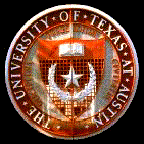
Department of Astronomy
The University of Texas at Austin
1 University Station C1400, RLM 16.224
Austin, TX 78712-0259
Email: sj@astro.as.utexas.edu
Phone: (512) 471 1395
Fax : (512) 471 6016
Office : RLM 16.224
URL : http://www.as.utexas.edu/~sj

|
Dr. Shardha Jogee Department of Astronomy The University of Texas at Austin 1 University Station C1400, RLM 16.224 Austin, TX 78712-0259 Email: sj@astro.as.utexas.edu Phone: (512) 471 1395 Fax : (512) 471 6016 Office : RLM 16.224 URL : http://www.as.utexas.edu/~sj |
|
|
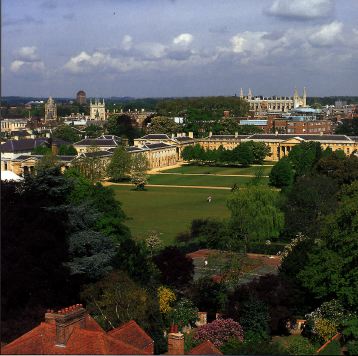
|
- NASA Long Term Space Astrophysics (LTSA) grant ($558,000), Mar 2003 (PI).
` Structure and dynamics of local and intermediate redshift disks'
- American Association of University Women Educational Fellowship (AAUWEF), 1996
- Amelia Earheart Fellowship, Zonta International, 1996
- Yale University J. F. Enders Research Grant, Yale University, 1995
- Sigma Xi Grants-in-Aid of Research, Sigma Xi Society, 1995
- Yale University J. F. Enders Fellowship, Yale University, 1995
- Garfinkel Prize, Yale University, 1992
- Elected to status of Fellow, Cambridge University, England, 1990-1992
- Undergraduate Academic Scholarship in Physics, Cambridge University, England, 1989-1992
My current research program addreses observational and theoretical aspects of the evolution, structure and activities of disk galaxies over a wide range of cosmic lookback times, from the present-day out to intermediate redshifts when the Universe was less than half of its present age. This research program involves the analysis of space-based ( HST, Chandra, SIRTF ) and ground-based optical,NIR, and radio data, as well as a concurrent collaborative development of the theoretical framework addressing disk evolution. I am a team member of the Galaxy Evolution from Morphology and SEDs (GEMS) Survey and the Great Observatories Origins Deep Survey (GOODS), which are the two largest multi-band surveys conducted to date with the Hubble Space Telescope's Advanced Camera for Surveys. I am also a member the STScI Home Team that planned the HST/ACS Ultra Deep Field (HUDF), which provides the deepest optical view of the Universe.
Research Interests
- Galaxy Formation and Evolution
- Structure and Dynamics of Galaxies from z=0 to 3, in particular : (1) Bar-Driven Evolution of Disk Galaxies ; (2) Strength and impact of tidal interactions/mergers on star formation, mass assembly history, and galaxy evolution.
- Evolution and Fueling of Central Starbursts and Black Holes (AGN)
- Interstellar Medium and Molecular Gas in Galaxies.
Research Group/Advisees
- Mar 2004--Present : Dr. Fabio Barazza, Postdoctoral Fellow, UT Austin and STScI
- As of May 2005: Irina Marinova, Graduate Student, UT Austin
- Apr 2005--Present: Kyle Penner, Dean's Undergraduate Scholar, UT Austin
- Jan 2004--Present : Dr. Ingo Berentzen, Postdoctoral Fellow (co-sponsored with Prof. Isaac Shlosman at the University of Kentucky)
- Nov 2002--Present: STScI Masters Level DAs/research scientists: James Davies, Inge Heyer
- June 2003--2004: Gabriel Lubell, undergraduate student, Vassar College/STScI
- Sep 2002--03: Naveen Reddy, graduate student, CalTech (co-supervised with Prof. Nick Scoville)
Excerpts of Research Projects
- Evolution of bars over the last 8 Gyr from the GEMS Survey: One third of present-day spirals host optically visible strong bars that drive their dynamical evolution. However, the fundamental question of how bars evolve over cosmological times has yet to be resolved. Drawing on a sample of 1590 galaxies from the GEMS survey, which provides morphologies from \it Hubble Space Telescope \rm Advanced Camera for Surveys (ACS) two-band images and accurate redshifts from the COMBO-17 survey, Jogee et al (2004) report that bars are abundant at intermediate redshifts of z ~0.2--1.0, and they certainly show no sign of a drastic decline at z >~0.7 as claimed by earlier studies (Abraham etal 1999). In fact, the large and similar bar fraction from the present-day out to different look-back times strongly suggests that on average bars have a long lifetime, well in excess of 2 Gyr. Thus, a comprehensive study of the impact and evolution of bars out to z~1 is a pre-requisite for developing any comprehensive picture of galaxy evolution over the last 8 Gyr. It is relevant for addressing the structural evolution of the Hubble sequence, and the dramatic decline in the cosmic UV luminosity density and SF rate (SFR) density from z~1 to the present-day.
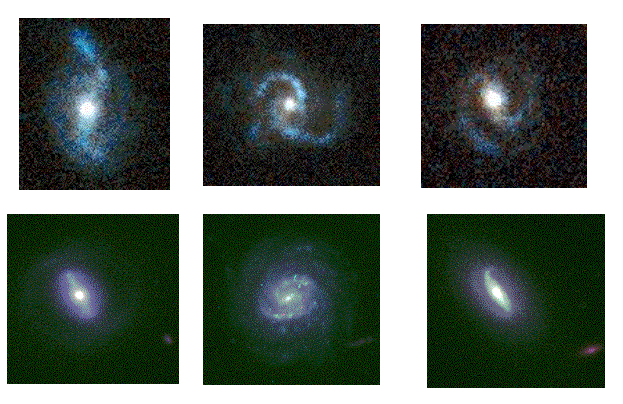
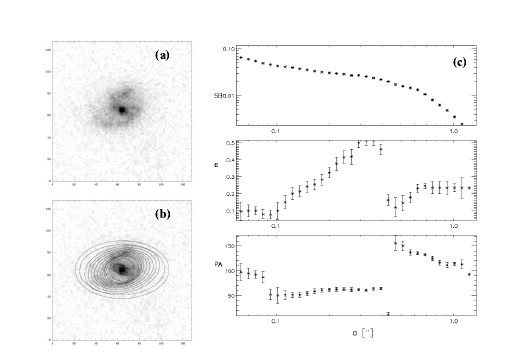 Left: Examples of bars and spiral arms in galaxies at redshifts z~0.3 and 0.4. (top panel:left to right), and at z~0.5 and 0.9 (bottom panel:left to right),from the (GEMS) survey. Right: This figure illustrates how we characterizate bars via ellipse fits out to z~1 when the Universe was less than half of its present age. The GEMS image of a z ~0.5 galaxy with a bar, prominent spiral arms, and a disk is shown without (a) and with (b) an overlay of the fitted ellipses. (c) In the resulting radial plots of the surface brightness, ellipticity e, and P.A., the bar causes a characteristic rise in e out to a global maximum, while the P.A. has a plateau. Beyond the bar end (a~0.36"), the spiral arms lead to a twist in P.A. and varying ellipticity before the the disk of lower $e$ dominates. (From Jogee et al (2004) )
Left: Examples of bars and spiral arms in galaxies at redshifts z~0.3 and 0.4. (top panel:left to right), and at z~0.5 and 0.9 (bottom panel:left to right),from the (GEMS) survey. Right: This figure illustrates how we characterizate bars via ellipse fits out to z~1 when the Universe was less than half of its present age. The GEMS image of a z ~0.5 galaxy with a bar, prominent spiral arms, and a disk is shown without (a) and with (b) an overlay of the fitted ellipses. (c) In the resulting radial plots of the surface brightness, ellipticity e, and P.A., the bar causes a characteristic rise in e out to a global maximum, while the P.A. has a plateau. Beyond the bar end (a~0.36"), the spiral arms lead to a twist in P.A. and varying ellipticity before the the disk of lower $e$ dominates. (From Jogee et al (2004) )
- Tidal Interactions and Mergers at Early Cosmic Times : We study the frequency and impact of tidal interactions and mergers out to z~1, when the Universe was half of its present age, in order to build a coherent picture of the decline in cosmic SFR density from z~1 to 0 and the mass assembly of galaxies (Jogee et al. 2003)
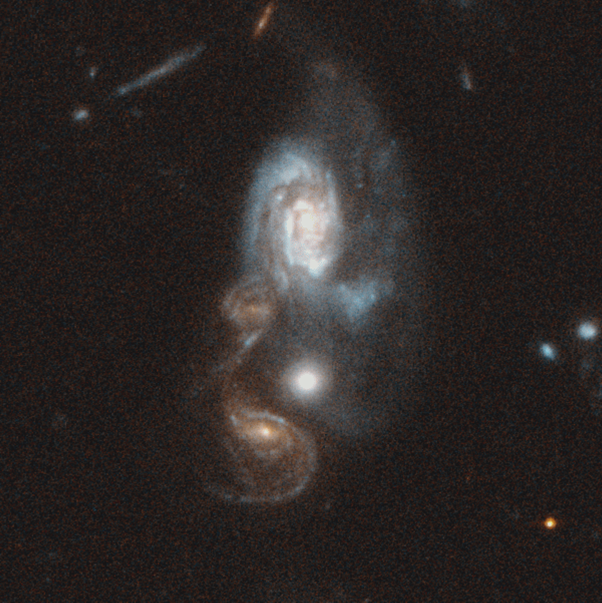 This figure shows a particularly spectacular double galaxy interaction in the GEMS field. In the foreground are two interacting spiral galaxies; while in the distant background there is another pair of interacting spiral galaxies (SOURCE: the GEMS collaboration)
This figure shows a particularly spectacular double galaxy interaction in the GEMS field. In the foreground are two interacting spiral galaxies; while in the distant background there is another pair of interacting spiral galaxies (SOURCE: the GEMS collaboration)
- The HST/ACS Ultra Deep Field (HUDF): The HUDF provides the deepest optical view of the Universe and reaches more than 1.5 mag deeper than the original Hubble Deep Field (HDF). Scientific drivers of the UDF include probing the tail of the reionization epoch, constraining the star formation history of the Universe, probing the faint end of the galaxy luminosity function, and tracking the origin, structure, and merger history of galaxies as they evolve onto and off the Hubble sequence.
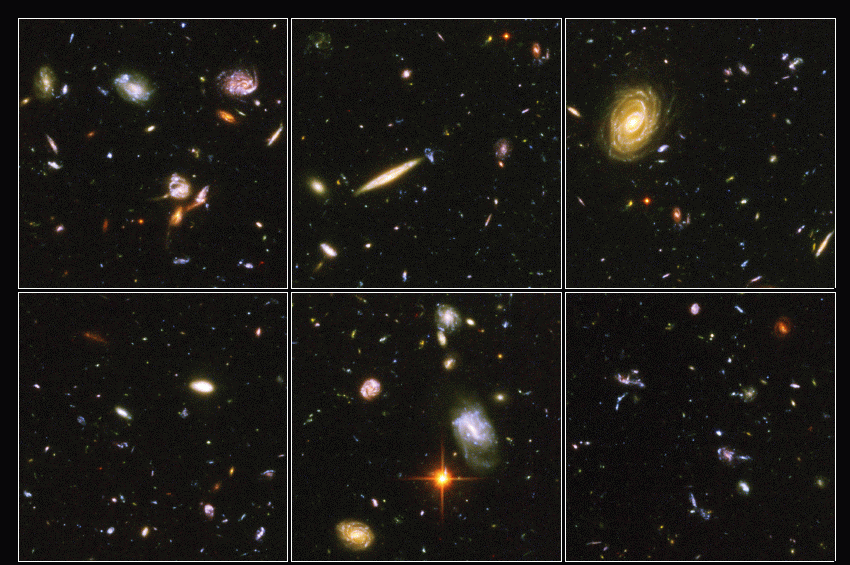 In 2004, HUDF team members planned and carried out observations lasting one million-seconds of the Hubble Ultra Deep Field (HUDF), the deepest visible-light image ever made of the Universe. These panels (Credit: NASA, ESA, S Beckwith and the HUDF team) from the HUDF reveal the first galaxies to emerge from the so-called "dark ages," the time shortly after the big bang when the first stars reheated the cold, dark universe Almost every panel shows oddball-shaped galaxies engaged in violent interactions with their neighbors and chronicles a period when the universe was younger and more chaotic. Order and structure were just beginning to emerge. The HUDF offers new insights into the origin, structure, and merger history of galaxies as they evolve onto and off the Hubble sequence, and sets constraints on what types of objects reionized the universe long ago.
In 2004, HUDF team members planned and carried out observations lasting one million-seconds of the Hubble Ultra Deep Field (HUDF), the deepest visible-light image ever made of the Universe. These panels (Credit: NASA, ESA, S Beckwith and the HUDF team) from the HUDF reveal the first galaxies to emerge from the so-called "dark ages," the time shortly after the big bang when the first stars reheated the cold, dark universe Almost every panel shows oddball-shaped galaxies engaged in violent interactions with their neighbors and chronicles a period when the universe was younger and more chaotic. Order and structure were just beginning to emerge. The HUDF offers new insights into the origin, structure, and merger history of galaxies as they evolve onto and off the Hubble sequence, and sets constraints on what types of objects reionized the universe long ago.
Popular Press /Articles
- Astrotheme (in German) Science Orf (in German)
- Le Mauricien (in French)
Education Outreach
WWW home page (last update Nov. 1, 2003)